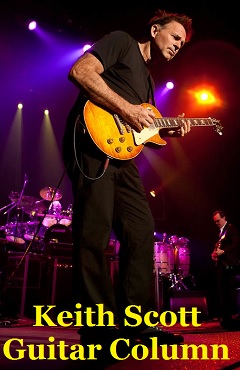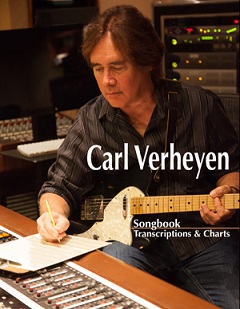Tony MacAlpine

Photo by Alex Solca
Guitar virtuoso Tony MacAlpine has just released his new studio album “Concrete Gardens”. Tony came out in the late 80s as one of the new generation shredding guitar heroes along with Paul Gilbert and Vinnie Moore. Later Tony also went on to take part in the Steve Vai Band, as well as the CAB project with Bunny Brunel and Dennis Chambers, broadening his musicianship and extending his career into a wider field in the music world. His latest studio effort displays a fine collection of tunes including various musical aspects from hard edged to melodic and dramatic, creating an excellent blend of music. The album not only shows Tony’s highly skilled guitar performances, but also proves his high ability of songwriting. MUSE ON MUSE asked Tony MacAlpine about his new album “Concrete Gardens”.

Photo by Alex Solca
Interview / Text Mamoru Moriyama
Translation Louis Sesto (EAGLETAIL MUSIC)
Muse On Muse : What kind of album did you aim to create with “Concrete Gardens”? What was the concept behind the album?
Tony MacAlpine : There is never a concept for me when it comes to creating an album and the music that ultimately ends up on them. Much time is spent in the writing process and it’s not something that I do with expectation, rather it’s a very organic writing process that is only complete when the music is telling a story. The selection of the musicians who will actually play on the album is a very integral part of the finished product, because this is where the real sound of, and direction of the music is shaped.
MM : Tell us how the songwriting and recordings were done for the album.
TM : The Concrete Gardens writing and recording process took the better part of a year and utilized the brilliant work of Primal Fear drummer Aquiles Priester and bass players Pete Griffin, Sean Delson, Lucky Islam and myself. All the primary tracks were created in my home studio, and all subsequent overdubs by the other musicians were completed at the studios of their choice. There are many complex music charts that all the musicians must follow and read, and from there we create the actual tracks. The album was mixed by Adair Daufembach in Brazil, and mastered by the legendary mastering engineer Seva.
MM : Songs such as “Man In A Metal Cage”, “Epic” and “Napoleon’s Puppet” have heavy parts while also having melodic progressions in the bridge, creating a beautiful contrast within the song. What do you keep in mind when structuring your songs?
TM : All my music is something that comes quite naturally for me. There is nothing I think about when creating and writing songs, as the process has to be very natural and real or there is just no point in doing it. Music for me is like a river and it must flow naturally and tell its story. In the end, the audience will have their own unique feeling about what they are hearing, including myself.
I spend a good deal of time listening to the music that I have written to gain a better perspective on the “art” aspect of it. If I feel it has reached me in a special way, and is current in my line of thinking at the time, and is very truthful then it will make it to the album. It’s not difficult to shelve songs that do not meet this criteria, because there is always another day and time and location to try again.
MM : Jeff Loomis takes part in “Square Circles”. How and why did he take part in this song? How was it working with Jeff?
TM : Jeff is a very good friend who I have admired for quite some time. His energy level when playing live is on high, and that is why it was so much fun to have him play live with me during the recording of the EMGTV video of “Concrete Gardens” live. When he worked on the track “Square Circles” he completed his solo at his own studio, so it was really only through the filming of the EMGTV video that we were able to experiment together in a live setting.
MM : The characteristics such as the breaks between phrases, and unique melodic expressions on “Exhibitionist Blvd.” and “Poison Cookies” seem to resemble a bit of Steve Vai.
TM : Well, I have been writing music with breaks and unique melodic expression since my very first album in 1986. I would say my greatest influences for creating music are fueled by my desire to continue to play and read as much as I can from the vast piano literature that exists in the public domain. It makes perfect sense to me however, that what people feel when they listen to music is completely dictated by their own personal wants and desires in music, as well as their own likes and dislikes.
MM : You end the album with a piano tune “Maiden’s Wish”. Why did you decide to finish the album with a piano song?
TM : Chopin is known to have written a number of other songs that are now lost. Some extant songs have been attributed to Chopin but are now considered spurious or doubtful. Luckily between 1847 and 1860, Chopin’s friend and great pianist /composer Franz Liszt arranged six of the Op. 74 songs as piano transcriptions under the title Six Chants polonais, S.480, a set which has long been a concert and recording favourite. The six are:
1. Mädchens Wünsch (No. 1: Życzenie – The Wish)
2. Frühling (No. 2: Wiosna – Spring)
3. Das Ringlein (No. 14: Pierścień – The Ring), which leads without a break into …
4. Bacchanal (No. 4: Hulanka – Merrymaking)
5. Meine Freuden (No. 12: Moja pieszczotka – My Darling)
6. Heimkehr (No. 15: Narzeczony – The Bridegroom)
Numbers 1 and 5 have always been my personal favorites of this set, so it was fitting for me to include one of these on the “Concrete Gardens” album.

Photo by Alex Solca
MM : There seems to be a swinging kind of comforting feeling in the way you play the piano, as if you were playing the guitar. I feel the same kind of vibe when listening to Eddie Van Halen play the piano. Would you say there is some kind of rhythmical characteristic typical to guitar players that causes this unique effect?
TM : I am not aware of this inner emotion you are experiencing, but I must say I have always loved Eddie Van Halen’s guitar playing so perhaps he has influenced my readings of piano literature in one way or another!
MM : This new album definitely shows that you have a talent in structuring songs, as well as creating great melodies. What do you find important when it comes to building up and improving your songwriting ability while pursuing a career in the music business?
TM : The music business is clearly not what it use to be. Over the last 20 years it has changed beyond just the format from vinyl to 8 track, and then again from cassette tape to CD, and further to digital downloads. The industry itself has evolved into something that has a wider angle than selling songs. My skill is that of writing music, and not the business end of it. As long as I stick to what I need to know about, I will stay on course and keep constructing many more guitar and piano recordings.
MM : Not only do you display a great performance of shredding guitar, but the album also shows some great nuances with the use of bending and vibrato, which definitely fascinates the listener. There are certain techniques that are not as flashy as shredding, but are definitely essential. Tell us your perspective on the essential techniques of guitar.
TM : The guitar is not the sole reason why the level of playing has risen so sharply and quickly in the last few years. The vast improvements in the amplifiers and components that go into the construction of the Instrument such as pick ups, bridges and electronic have a lot more to do with this then most people realize. As far as the tools of playing are concerned, I started playing music at the age of 5 at the Springfield Conservatory of Music in Massachusetts, and was taught early that technique is a mere tool, and not the most important thing in achieving completeness as a musician. I operate musically from a more emotional side, and the hard attributes of playing are not as important to me as the actual truth telling of music expression as a whole. And if you notice, that is why there are so many players that can do some amazing things, but fail to reach the listeners on an emotional level. Emotion is the essential technique in all music making…without it, in my opinion, it’s just not interesting.
MM : Tell us about each song on the album. How the song came to be, about any background or meaning behind the song, etc.
TM : The entire album was written and composed over the summer and winter of 2014. Many of the songs were completed in very short order, and some were not and were more time consuming to finish. The “Maidens Wish” comes from me reading the piano literature, and I didn’t write the piece. Some of the tunes were composed with a specific place of being in mind – for example “Sierra Morena” reflects the great mountain ranges in Spain across the Iberian Peninsula. “Red Giant” is written about a very big star in the solar system. These songs were very conceptual. Songs like “Concrete Gardens” and “Exhibitionist Blvd” were composed towards the beginning of the writing process. Epic was a track that took much time to complete, as it went through various changes before settling on its current foundation that is heard on the album. “Man in a Metal Cage” was composed with the thought of experimental test pilots in mind – I love to watch the evolution of flying machines on various TV shows from time to time. “Square Circles” was written towards the end with Jeff Loomis in mind, as I needed a cool piece of music for us to play together on. “Poison Cookies” and the rest of the songs were written in the mid-point of my writing the album, and the bulk of influences of these tunes are from a more personal and fictional place.
MM : You guested on Japanese guitar player ISAO’s “Spark7” album. How and why did you take part in ISAO’s project? How was playing with ISAO?
TM : I was contacted by bassist Philip Bynoe, and asked if I would participate on the CD, because Isao had been trying to reach me and Phillip Bynoe was already working with him. I have never played with Isao in person. I simply went to my studio and contributed to the parts that I received from him. The track I heard was very energetic and fun!
MM : Please tell us about your gear. What guitars, guitar amps, effectors, foot pedals did you use for this recording?
TM : I use Ibanez 7 and 8 string neck-throu-body guitars, with Floyd Rose and Ibanez’s own tremolo systems, and EMG pickups. I also use Hughes & Kettner Coreblades live, and TriAmps in the studio. On my pedal board, I use Ernie Ball volume and wah pedals, as well as some Voodoo Lab pedals, and Source Audio distortion.
MM : Please give the Japanese fans a message.
TM : I am happy to create and serve the music-minded listeners of the world, and for years Japan has always been one of my favorite places to play. I hope to see you again soon!!
Tony MacAlpine Official Site : http://www.tonymacalpine.com/
Tony MacAlpine Official facebook : http://www.facebook.com/tonymacalpineofficial
Tony MacAlpine Official twitter : www.twitter.com/tonymacalpine

Tony MacAlpine / Concrete Gardens
1. Exhibitionist Blvd.
2. The King’s Rhapsody
3. Man In A Metal Cage
4. Poison Cookies
5. Epic
6. Napoleon’s Puppet
7. Sierra Morena
8. Square Circles
9. Red Giant
10. Confessions of a Medieval Monument
11. Concrete Gardens
12. Maiden’s Wish

